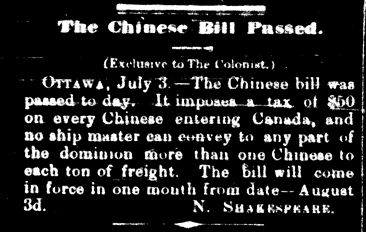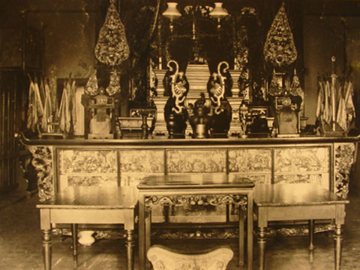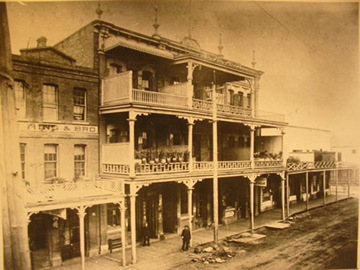The Chinese Consolidated Benevolent Association
The Chinese Consolidated Benevolent Association was established in 1884 as the only Chinese consulate in Canada, until a consulate was created in Ottawa in 1908.7 After the work on the Canadian Pacific Railway was complete Chinese immigrants flocked to Victoria to set up residence. By 1884 the Chinese population in Victoria was 1,767, the largest Chinese community in British Columbia.8 In 1884 Victoria was experiencing a boom in buildings and in population, making Victoria the metropolis of British Columbia. Although Victoria was home for the largest Chinese community in the province, many of the Chinese immigrants were suffering from illness. The Chinese were without a governing body of their own, creating a need for some type of an organization to help the Chinese people find jobs and organize community events. The most important reason that the Chinese community needed the association was “to unite the Chinese in British Columbia in their protest against the discriminatory laws passed by the provincial government”9, such as the $50 fee that all Chinese over the age of 14 were required to pay to live in Canada.

Not only did the Chinese residents of Victoria require an association to protect themselves from discrimination of the white community, but also to maintain law and order within the Chinese community. The Chinese would respect and listen to a system of laws created for themselves by individuals of their own ethnicity.
The Chinese community of Victoria sought approval to establish their own Chinese association from the existing Chinese Consul-General in San Francisco, Huang Cunxian, through a letter in 1884.10 This letter explained the head tax on the Chinese, by the Federal government, the unrest amongst the Chinese inhabitants with no order or control, and the awful conditions in which the Chinese communities lived sick, cold, and hungry. The Chinese Consul-General in San Francisco approved Victoria’s need for a Chinese association to handle the issues mentioned in the letter. The Chinese Consul sent Huang Xiquan to assist the Chinese merchants in Victoria in setting up an association. Huang Xiquan played a large role in the establishment of the Chinese Consolidated Benevolent Association by setting up the rules and regulations.11
A notice was released addressing all of the Chinese people in B.C., stating that a $2 fee per Chinese individual must be collected prior to October 3, 1884 to help fund the establishment of the CCBA. Any person failing to make this contribution would be required to pay a fee of $10 prior to returning home to China.12 These fees were mandatory to allow this project to be successful. Many did not oppose the mandatory fee rule because the association was viewed as a good thing for the Chinese community of Victoria. Returns came from Vancouver Island and from the mainland indicating that “the Victoria merchant elite held considerable power in these communities or that there was present a strong desire for an all-Chinese association even in centers remote from the capital.”13 Those that did refuse to pay the fee would be refused protection by the CCBA. By May 27, 1885 approximately $30, 000 was raised and construction began.14 Printed in the Daily Colonist in March 1885, was a description of what the building was meant to serve as, “the ground floor is to be used as storage . . .[t]he second floor is evidently intended for the use of a society, the arrangements being of rather a peculiar and confusing nature. The upper story is to be used as a Joss-house”15, obviously the story written by an ill-informed white reporter, as the details were fairly unclear. July 1885 the building was completed at the location of 558 Fisgard Street.

Altar
at the Palace of the Saints, in the CCBA
The main function of the CCBA was clearly stated in its constitution:
This association
has been established in order to express
our feelings of unity, to undertake social welfare, to settle
disputes, to aid the poor and the sick, to eliminate evils within
the community, and to defend the community against external
threat.16
In June
the CCBA was set up with a body of elected officers. Li Youchin was
the first president of the CCBA. There were various other offices
such as treasurer, secretaries and trustees. One of the crucial persons
belonging to the CCBA was the interpreter, the first being Won Alexander
Cumyow, he was “able to perform the important function of interpreting
between the Chinese and the white communities.”17 Once the
offices were elected, the rules and bylaws were to be drawn up. On
August 18, 1884 an english copy of “The Rules and By-laws of the Chinese
Consolidated Benevolent Association” was presented to the Registrar
of Companies.18
The rules/regulations was split into two parts. The first section
was devoted to defining the objections and functions of the CCBA.
The second section was the larger of the two and its concerns were the administration
of the Association, how the CCBA was to deal with disputes among the Chinese
and among the white community, and finally, social welfare. The CCBA
was created to protect the Chinese immigrants of Victoria, including caring
for the poor and sick and working to reduce internal troubles. The
final function of the CCBA was to act as a sponsor to the poor. Those
over sixty years old without money would be provided a trip home by the
CCBA funds.19 The CCBA
also ran a home for the sick and poor, which eventually became the Chinese
hospital. The CCBA worked to stop the exploitation of Chinese women
as prostitutes. Article 20 of the “Rules and By-laws of the
Chinese Consolidated Benevolent Association” stated:our feelings of unity, to undertake social welfare, to settle
disputes, to aid the poor and the sick, to eliminate evils within
the community, and to defend the community against external
threat.16
If anyone informs the Association that a young girl
has been kidnapped and sold in this city, the buyer
will be forced to set the girl free. The Association
will look after sending her to the Tung Wah Hospital
in Hongkong, which will inform the family. In case the
girl has no family, the Tung Wah Hospital will arrange
for her to marry a decent man.20
It has been suggested by Dr. Lai that the function and activities of the CCBA can be categorized into 4 parts.
1. The Association’s organization of protests against discriminatory laws and taxes.
2. The arbitration and maintenance of peace and order in Chinatown.
3. To raise funds to send relief, to other cities in Canada, to China and to other Chinese communities in the world.
4. The administration of a hospital, a cemetery and a school.

The Chinese Consolidated Benevolent Association